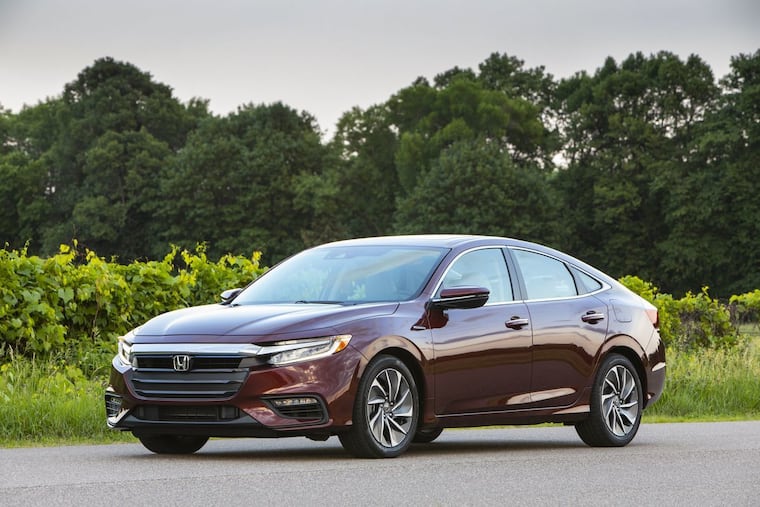Honda Insight gives fuel efficiency a Civics lesson
The Honda Insight is based off the Civic platform for 2019. While it offers better fuel economy, the engine noise and driver comfort leave a lot to be desired.

2019 Honda Insight Touring: More affordable economy.
Price: $28,985 as tested (no options on test vehicle). A base model starts at $22,380.
Conventional wisdom: Consumer Reports liked the “fuel economy, ride, and standard AEB,” but not the “gear selector, controls, front-seat comfort” and that the “low stance hurts access.” Motor Trend likes the “smart style and packaging, excellent ride, lane centering technology,” but not “the roaring, thrashy powertrain.”
Marketer’s pitch: “As beautiful as it is efficient.”
Reality: If you like the Civic and saving fuel, this is the unit for you.
Catching up: Last week, we took a spin in the Kia Niro Plug-in, which offers a roomy plug-in hybrid wagon, but for six grand more than this cordless Honda sedan. Will the savings make the Insight worthwhile?
What’s new: All of it. The Insight gets a new look and new features for 2019; it’s now based off the Civic, so use that as your guide.
Up to speed: The 1.5-liter four-cylinder engine and hybrid motor team up to provide a total of 151 horsepower.
Necks will not be snapped while accelerating. Getting to 60 mph takes 7.7 seconds, according to Motor Trend, but that strikes me as really optimistic. Sport mode does make acceleration strikingly better but fuel economy substantially worse.
The engine-hybrid drive setup is unlike most other companies’, though; the engine sounds don’t match the speed of the car. So a roar from the front might not be accompanied by a pulling movement. Strange, unless you’ve experienced the Chevrolet Volt or other similar cars; it’s nothing like a Prius or other Toyotas.
Fuel economy: I averaged about 42 mpg in the usual Mr. Driver’s Seat world of testing, although with a few more highway miles added. Feed the Insight anything you like.
Note that the Touring has a fuel-economy rating of 51 mpg, while the lesser levels are 55.
Shiftless: No gears are available with the hybrid-drive setup with its continuously variable transmission. Paddle shifters on the steering wheel almost fooled Mr. Driver’s Seat, but they merely offer different levels of regenerative braking to restore battery charge.
On the road: Handling in the Insight could not be called “fun.” The car goes around turns without much excitement.
Driver’s Seat: Not surprisingly, the Insight’s seats take a page from the Civic. Plenty of lumbar support without any room for adjustment leaves Mr. Driver’s Seat a little cranky; people who enjoy their lumbar pressed tightly will appreciate this. Fortunately, I found a way to sit that takes some of the pressure off my spine. A previous Civic sedan test drive left me quite cranky, although the hatchback and I got along fine.
An Insight sits fairly low to the ground, and headroom is snug for the 5-10 Mr. Driver’s Seat. Taller people may not fit (and, for those Hondaphiles, appropriately, there’s the Fit).
Friends and stuff: Forget what you think you know about the Insight; the newest version has grown much bigger. Rear-seat passenger room is not at all bad. Legroom and foot room are generous, while headroom is a bit snug.
Cargo space is 14.7 cubic feet for the Touring, 15.1 for the other trim levels.
Play some tunes: After years of gushing over Honda sound systems, I found the Insight worse than expected. (I find this satisfying, because sometimes I fear I’m losing my snark.) Plenty of audio adjustments are available, but none turned the speakers into a rich aural experience.
A knob controls volume, but otherwise it’s all touchscreen, baby. Getting from station to station or finding iPod songs can be a bit of a challenge. Buttons along the side of the screen do change functions (audio, map and more).
Night shift: Those touchscreen buttons become difficult at night, though. The word audio is lighted, but the button below it is not. So some learning must take place before this becomes easy.
Keeping warm and cool: Dials control temperature for driver and passenger side, while buttons control the fan speed and where the air comes from. Adjustments are not difficult, but dials would be more user-friendly, and the tiny icon for airflow can be hard to see.
Editor’s note: An earlier version of this column misstated the function of the paddle shifters.
Where it’s built: Greensburg, Ind.
How it’s built: Consumer Reports predicts its reliability will be a 3 out of 5.
In the end: Though 42 mpg in Mr. Driver’s Seat’s world is nothing to sneeze at, I still like the idea of a plug-in, especially for people who commute short distances a lot or who have a heavy foot. Plus, the driver discomfort of the Civic is replicated in the Insight. I’d probably pay the freight for the comfort, convenience, and driveability of the Niro PHEV.